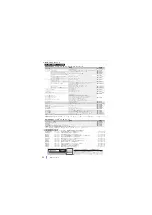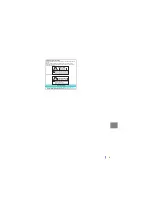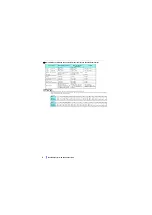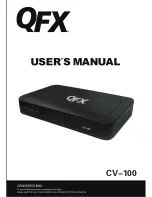
14
PRECAUTIONS FOR USE OF THE INVERTER
4
PRECAUTIONS FOR USE OF THE INVERTER
The FR-B, B3 series inverter is a highly reliable product, but incorrect peripheral circuit making or operation/handling method may shorten the product life or
damage the product. Before starting operation, always recheck the following points.
• Use crimp terminals with insulation sleeves to wire the power supply and the motor.
• Application of power to the output terminals (U, V, W) of the inverter will damage the inverter. Never perform such wiring.
• After wiring, wire offcuts must not be left in the inverter.
Wire offcuts can cause an alarm, failure or malfunction. Always keep the inverter clean.
When drilling mounting holes in an enclosure etc., take caution not to allow chips and other foreign matter to enter the inverter.
• Use an appropriate cable gauge to suppress the voltage drop to 2% or less.
If the wiring distance is long between the inverter and motor, a voltage drop in the main circuit will cause the motor torque to decrease especially during the
output of a low frequency.
Refer to
for the recommended cable gauge.
• Keep the total wiring length within the specified length.
In long distance wiring, charging currents due to stray capacitance in the wiring may degrade the fast-response current limit operation or cause the equipment
on the inverter's output side to malfunction. Pay attention to the total wiring length. (Refer to
• Electromagnetic wave interference
The input/output (main circuit) of the inverter includes high frequency components, which may interfere with the communication devices (such as AM radios)
used near the inverter. In this case, activate the EMC filter (turn ON the EMC filter ON/OFF connector) to minimize interference. (Refer to Chapter 3 of the
FR-A800 Instruction Manual (Detailed).)
• Electrical corrosion of the bearing
When a motor is driven by the inverter, axial voltage is generated on the motor bearing, which may cause electrical corrosion of the bearing in rare cases
depending on: condition of the grease used for the bearing, wiring, load, operating conditions of the motor, or specific inverter settings (high carrier frequency,
EMC filter ON).
Refer to JEM-TR169 (technical report issued by the Japan Electrical Manufacturers' Association) or contact your sales representative to take appropriate
countermeasures for the motor.
The following shows examples of countermeasures for the inverter.
• Decrease the carrier frequency. (FR-B)
• Provide a common mode choke on the output side of the inverter.
• Turn OFF the EMC filter.
• Do not install a power factor correction capacitor, surge suppressor or capacitor type filter on the inverter's output side.
Doing so will cause the inverter to trip or the capacitor and surge suppressor to be damaged. If any of the above devices is connected, immediately remove it.
• For some short time after the power-OFF, a high voltage remains in the smoothing capacitor, and it is dangerous.
A smoothing capacitor holds high voltage some time after power-OFF. When accessing the inverter for inspection, wait for at least 10 minutes after the power
supply has been switched OFF, and then make sure that the voltage across the main circuit terminals P/+ and N/- of the inverter is low enough using a tester,
etc.
• If "EV" is displayed on the operation panel, turn OFF the 24 V external power supply before performing wiring.
• A short circuit or earth (ground) fault on the inverter's output side may damage the inverter module.
• Fully check the insulation resistance of the circuit prior to inverter operation since repeated short circuits caused by peripheral circuit inadequacy or an
earth (ground) fault caused by wiring inadequacy or reduced motor insulation resistance may damage the inverter module.
• Fully check the to-earth (ground) insulation and phase-to-phase insulation of the inverter's output side before power-ON.
Especially for an old motor or use in hostile atmosphere, securely check the motor insulation resistance, etc.
• Do not use the magnetic contactor (MC) on the inverter's input side to start/stop the inverter.
Since repeated inrush currents at power ON will shorten the life of the converter circuit (1,000,000 times for others), frequent starts and stops of the input side
MC must be avoided. Turn ON/OFF the inverter's start signals (STF, STR) to run/stop the inverter. (Refer to
• Across terminals P/+ and PR, connect only an external brake resistor.
Do not connect a mechanical brake.
• Do not apply a voltage higher than the permissible voltage to the inverter I/O signal circuits.
Application of a voltage higher than the permissible voltage to the inverter I/O signal circuits or opposite polarity may damage the I/O devices. Especially
check the wiring to prevent the speed setting potentiometer from being connected incorrectly to short circuit terminals 10E and 5.
• If the machine must not be restarted when power is restored after a power failure, provide an MC in the inverter's input side and also make up a
sequence which will not switch ON the start signal.
If the start signal (start switch) remains ON after a power failure, the inverter will automatically restart as soon as the power is restored.
• MC on the inverter's input side
On the inverter's input side, connect an MC for the following purposes. (For the selection, refer to Chapter 2 of the FR-A800 Instruction Manual (Detailed).)
• To disconnect the inverter from the power supply at activation of a protective function or at malfunctioning of the driving system (emergency stop, etc.).
• To prevent any accident due to an automatic restart at power restoration after an inverter stop made by a power failure.
• To separate the inverter from the power supply to ensure safe maintenance and inspection work.
If using an MC for emergency stop during operation, select an MC regarding the inverter input side current as JEM 1038-AC-3 class rated current.
• Handling of the magnetic contactor on the inverter's output side
Switch the magnetic contactor between the inverter and motor only when both the inverter and motor are at a stop. When the magnetic contactor is turned
ON while the inverter is operating, overcurrent protection of the inverter and such will activate.
• Countermeasures against inverter-generated EMI
If electromagnetic noise generated from the inverter causes the frequency setting signal to fluctuate and the motor rotation speed to be unstable when
changing the motor speed with analog signals, the following countermeasures are effective.
• Do not run the signal cables and power cables (inverter I/O cables) in parallel with each other and do not bundle them.
• Run signal cables as far away as possible from power cables (inverter I/O cables).
• Use shielded cables.
• Install a ferrite core on the signal cable (Example: ZCAT3035-1330 TDK).
• Instructions for overload operation
When performing frequent starts/stops by the inverter, rise/fall in the temperature of the transistor element of the inverter will repeat due to a repeated flow of
large current, shortening the life from thermal fatigue. Since thermal fatigue is related to the amount of current, the life can be increased by reducing current
at locked condition, starting current, etc. Reducing current may extend the service life but may also cause torque shortage, which leads to a start failure.
Adding a margin to the current can eliminate such a condition. Reducing the current may extend the service life but may also cause torque shortage, which
leads to a start failure. Adding a margin to the current can eliminate such a condition. Use both an inverter and a motor of higher capacities.
• Make sure that the specifications and rating match the system requirements.
















































